Nerite snails are the perfect freshwater algae cleanup crew for any new hobbyist. These one-inch aquatic animals are resilient and require incredibly minimal care to clean your tank, making aquarium maintenance much more manageable.
They are preferred as algae feeders over mystery snails because their small size makes them a perfect fit for 5-gallon tanks. They mitigate the effects of algae buildup while acting as attractive aquarium décor with their multicolored and multipatterned shells.
Read on to get up to speed about everything that has to do with Nerite snails, particularly in the context of an aquarium fish tank. Get to know about the essential Nerite snail care procedures that will give you impressive results for up to 2 years.
What Are Nerite Snails?
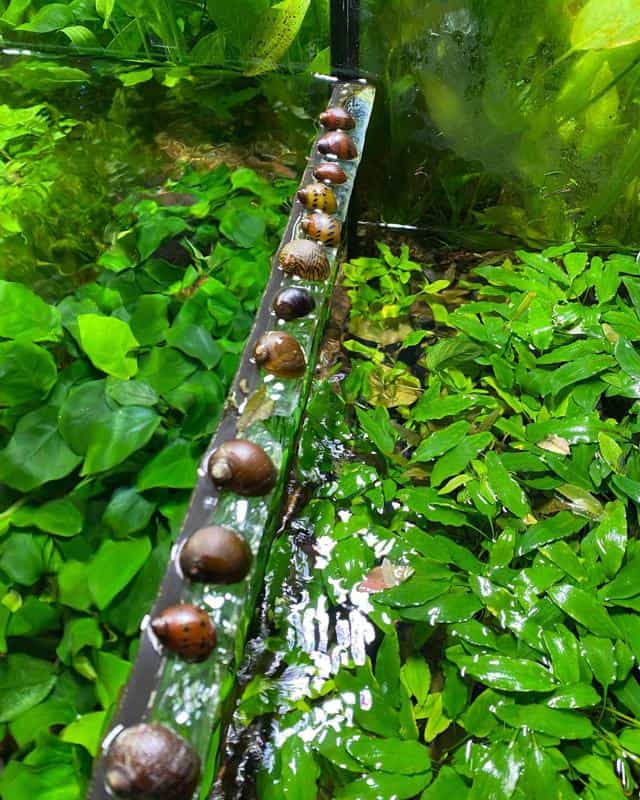
| Names | Nerite ( Vittina natalensis), also Neritina natalensis, Theodoxus natalensis |
| Origins and Reginal Distribution | East African coasts in Kenya, Somalia, and Tanzania, as well as Mozambique and South Africa |
| Water Hardness Conditions | Freshwater: 6 – 12 dGH
Saltwater: 15 – 18 dGH |
| Lighting Conditions | Moderate with no direct bright sunlight |
| Average Size | 0.5 inches to 1.5 inches |
| Colors | Vary according to type featuring many colors and spots |
| Lifespan | 1 – 2 years |
| Food | Algae, dead leaves, and small leafy vegetation |
| Breeding | Saltwater conditions with 12 degrees of hardness |
| Optimal pH levels | 7 – 8.5 |
| Optimal Temperature | 65 – 85 degrees Fahrenheit |
Scientifically known as Vittina natalensis, the Nerite snails are popular because of their algae-feeding properties as well as their attractive shells. These snails are populated worldwide but only breed in marine conditions with highly salinized brackish waters. Their major distribution is in the coastal regions of East Africa.
They are small creatures with an average size of about one inch, but they become bigger with age. Nerite snails can be as small as 0.5 inches and as big as 1.5 inches, which is between the size of a dime and a quarter. There is a considerable shrinkage compared to their rival, the Mystery snails, used for the same job.
Nerites have a solitary and peaceful temperament that makes them a breeze to take care of. However, their calming demeanor is also their most debilitating trait since it makes them an easy target for aggressive snail-eating aquatic life like goldfish and loaches.
These peaceful snails have a shorter lifespan than Mystery snails, about 1 -2 years, compared to the Mystery snails that can live up to 3 years. However, it is important to keep in mind that the Nerites can have shorter lifespans if the aquatic habitat is not favorable; they sometimes die in weeks.
Weak shells caused by low calcium levels are one reason the lifespan may be shorter. They are also sensitive to copper, like lots of aquatic life and high nitrite levels are fatal to them as they are to fish.
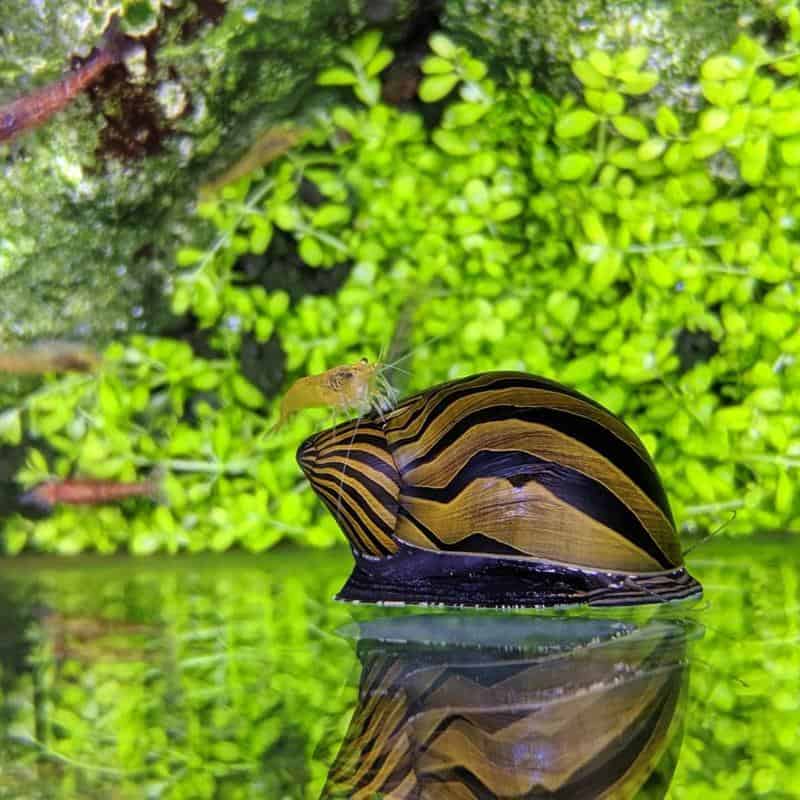
You are bound to find many types of Nerite snails in your local pet store, but the most prevalent one is the Zebra Nerite snail with uneven light strips of gold, yellow, and brown. Other types include:
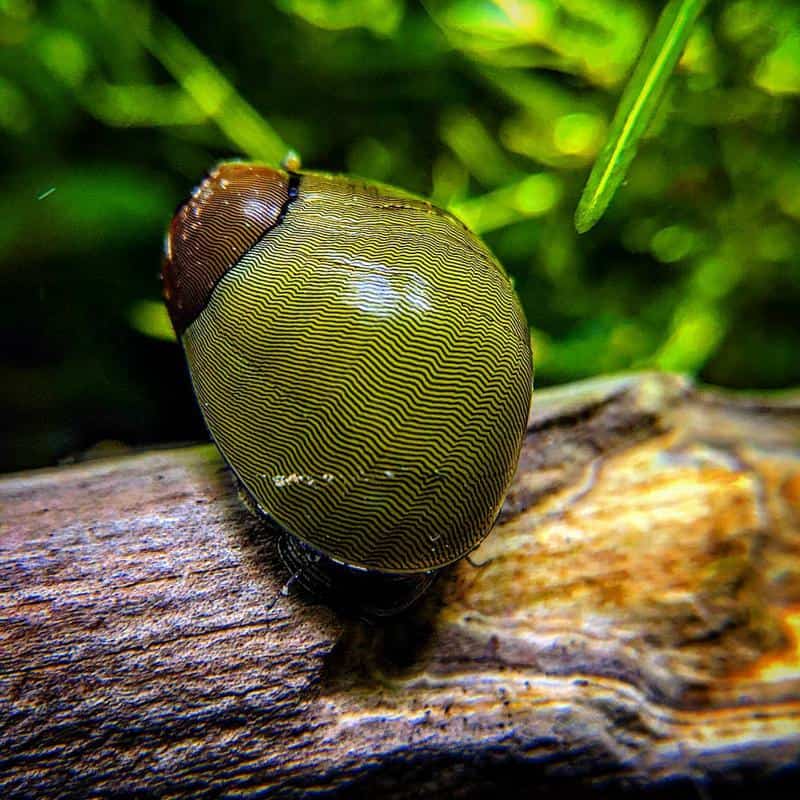
- Olive Nerite snail with a brown-green round & smooth shell. Usually less than an inch long.
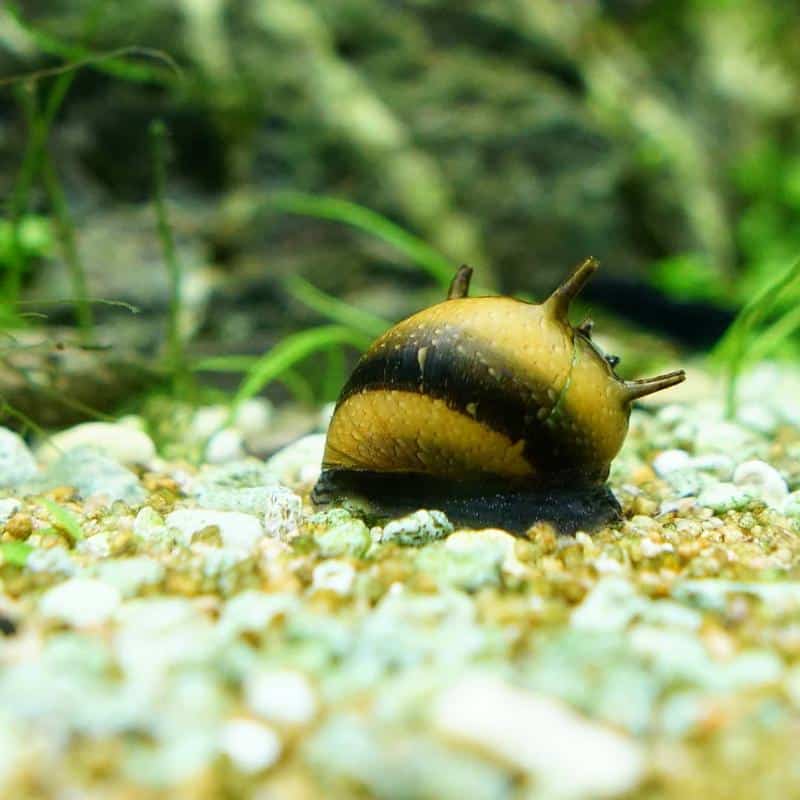
- Horned Nerite snail with spikes coming out of the shell. It is also known as the Bumblebee snail due to its color.
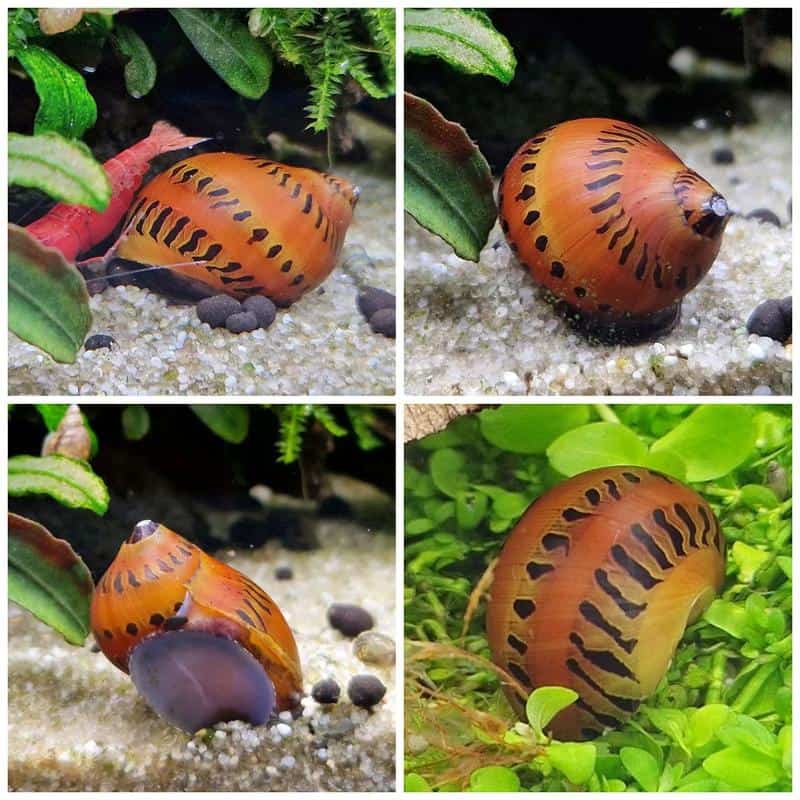
- Tiger Nerite snails with dotted stripes similar to those of a tiger. Its color is a combination of dark amber and black spots.
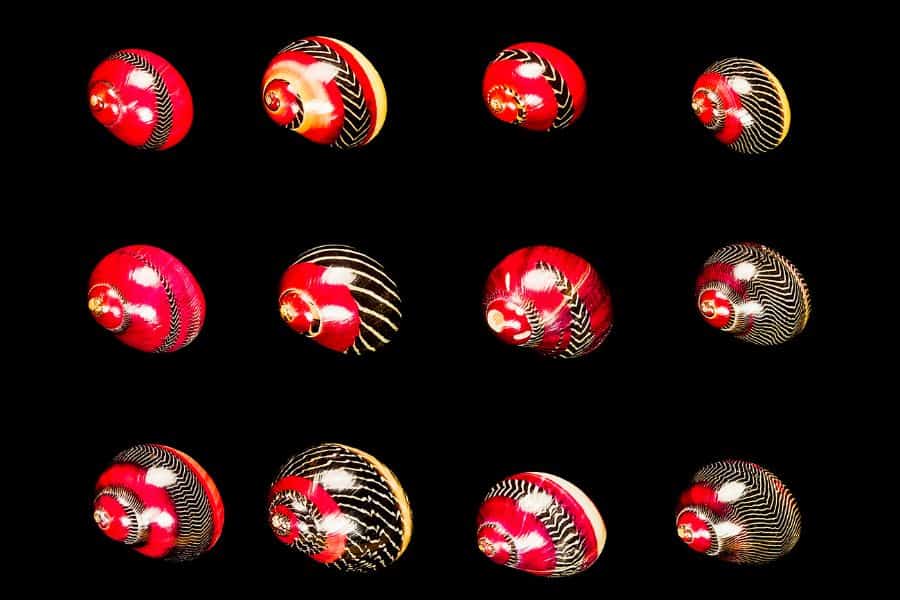
- Red Racer Nerite snails are the fastest of the bunch and feature grooves on their dark red shells.
Are Nerite Snails Good for Your Tank?
As stated earlier, Nerite snails are great solutions for beginners who want to populate their aquarium tanks with functional yet attractive creatures. However, how do you know if Nerites fit your specific use case? Here are a few outlines:
Fit Into Smaller Tanks
So, how many nerite snails per gallon?
A big concern to any hobbyist is the number of aquatics in their habitat. Introducing a new species into the mix can raise questions about whether they fit into the system and how they will grow over a long period.
One Nerite snail is recommended for a five-gallon tank. That means you will need about two for 10 gallons and 4 for 20 gallons.
Since the lifespan of Nerites usually lasts about a year, you can rest assured that one stock will have you covered for a long time. And since size matters, you do not want them to breed rampantly. For that, there is sine good news.
Low Maintenance Solution
Nerite snails only breed in brackish water, which makes them a great choice for freshwater tanks. This means you will not worry about overpopulation or a huge amount of waste production.
The snails can also be used in a saltwater tank, but you will have to consider their breeding during fertilization. Fish acclimation and transfer into a marine water system will be necessary if you want them to breed for freshwater purposes.
A temperature of about 70 degrees Fahrenheit is sufficient, and the pH levels are alkaline, above 7.
Nerites are non-invasive with their peaceful idle lifestyle. They are slow but active movers scavenging on algae and dead aquarium vegetation when busy.
They mostly feed on algae unless the algae reproduction is low, which will only require you to feed them small slices of vegetables like kale and spinach.
Remember that Nerites thrive in a habitat filled with non-aggressive, no-snail-eating animals only.
Hardy Creatures
You would think such small creatures are not resilient, but you would be wrong. Nerite snails are hardy aquatics that can withstand a few changes and spikes in ammonia but less on nitrate. Their highest sensitivity is to low calcium content and high concentration of copper from sources like tap water.
All in all, Nerite snails are a perfect solution in most aquarium tank cases provided there is enough algae and no aggressive animals that feed on snails.
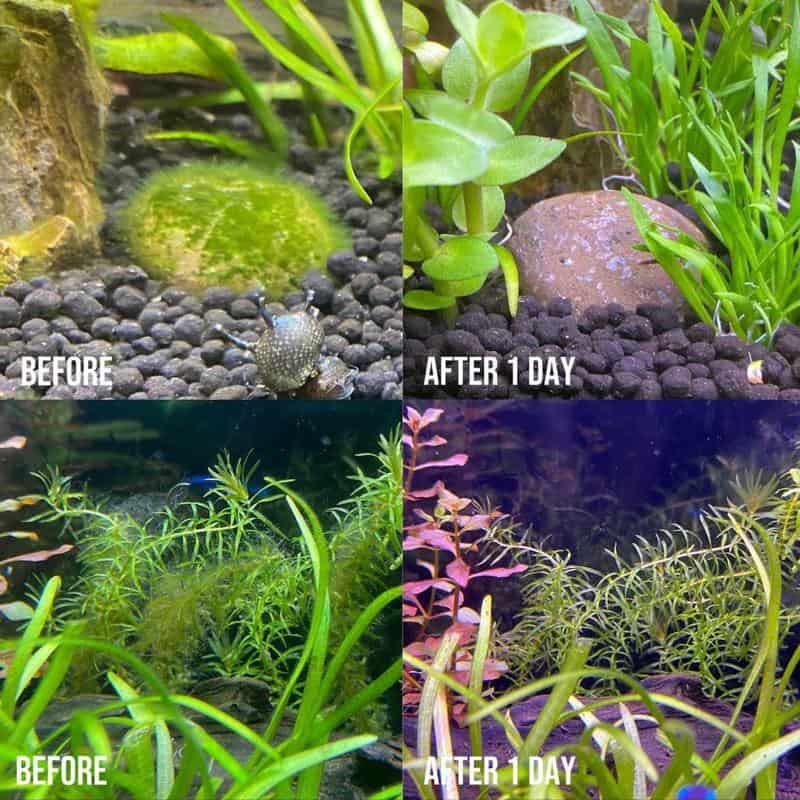
When to introduce Nerites – only introduce Nerites in the tank to feed on naturally present, medium-level algae. It is vital to remember that Nerites won’t solve your algae problems if there is a bigger root cause. Nerites can only clean the tank by feeding on naturally present algae that isn’t affected by other excessive conditions.
Excessive conditions that promote extra algae growth include lots of uneaten fish food in the tank, excessive lighting, and high nutrient buildup.
Nerite Snail Care
Nerite Snails need little care for them to thrive in an aquarium system. They are great at adapting to various freshwater or saltwater environments and need little food to survive.
Nerites make the best algae-cleaning solution for newbies in this regard, but you will need to keep a few things in mind: the kind of food they eat and how they get it, water conditions in different aquariums, and the constituents of the habitat.
Nerite Snails Food & Diet
If you are asking, do I need to feed my Nerite snail? Then the answer is no, so long as your tank is in perfect optimal condition. It would be best if you rarely had to feed the Nerite snails in your aquarium. Algae will naturally be present at the bottom, and the gravel will promote more algae growth, creating a self-sustaining ecosystem.
If algae are less, you can add small leafy vegetables like spinach, kale, zucchini slices, and lettuce to provide the Nerites with the daily nutrients. Calcium from these greens is enough, but it is advisable to use some additives, the Zoo Med Nano Banquet Food Blocks.
Nerite snails rely on calcium to make their shells hard and prevent them from peeling or breaking. You will start seeing the snails having eroded shells with loser colors when they lack calcium.
Another question you may be asking is, do nerite snails eat plants?
And as you have already guessed, No. Nerites do not eat live plants; they are scavengers who feed on leftovers and decaying leaves – unhealthy and dead vegetables. They also ravage anything they find, including food on the filters and glass surfaces.
One thing you will need to keep an eye on to feed Nerites properly is algae production. Nerites love soft green and soft brown algae as well as brown diatoms.
If the supply of these foods diminishes, adding some rocks into the tank is recommended to increase algae production. You should also only put Nerites in the tank once algae are moderately populated across the tank floor.
Water Conditions for Nerites
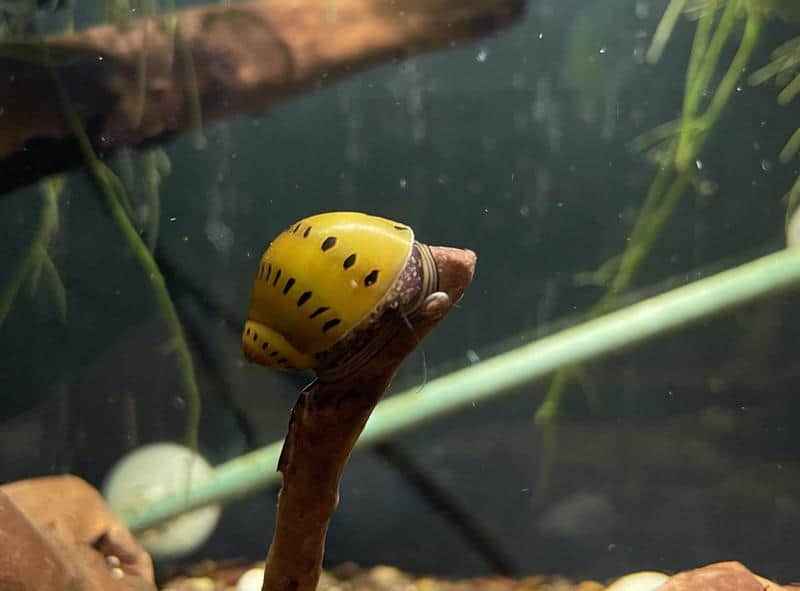
Always keep the water conditions stable to avoid stressing the Nerites. They respond to changes in water quality and parameters like any other aquatic.
Temperatures between 70 to 80 degrees Fahrenheit are recommended, but you can get away with about 65 to 85 degrees Fahrenheit as well. Keep the pH level above 7, preferably between 7 and 8.5: the higher, the better.
Fresh water is encouraged since it limits breeding, but you can put the Nerites in salt water, provided you know their breeding cycles. Also, saltwater has little calcium content compared to fresh water. Try adding calcium sand to salt water or even fresh water to increase calcium levels.
12 degrees of water hardness is needed for the Nerites to survive. You can try spiking the water with mineral salts to make the water harder and more habitable.
Like fish, Nerite snails are sensitive to spikes in Ammonia/nitrate as well as external contaminants like copper. Copper can easily enter the habitat from tap water. Try using powerful absorbents of heavy metals to get rid of copper contamination; a good example is CupriSorb.
With their small size, the size of the tank should not be a problem. It is the best snail type for cleaning algae in the smallest of tanks and can serve an idle one-inch creature. However, you may consider getting a tank that can simulate a slight moving current; the Nerites are healthier in such conditions.
Habitat Conditions for Nerites
Tank Mates Compatible with Nerite Snails
The first habitat question when getting Nerites is: What fish can live with Nerite snails?
It would be best not to place the Nerites in a tank containing snail-eating animals like snail-eating loaches, pufferfish, crayfish, goldfish, or cichlids.
Nerites thrive next to small, peaceful non-snail-eating aquarium life like barbs, bettas, guppies, neon tetras, cherry shrimp, bamboo shrimp, ghost shrimp, vampire shrimp, Cory catfish, Ivory snails, trumpet snails, and mystery snails.
Ensure the animals in the habitat are compatible with Nerite snails before purchasing them for algae cleanup.
How Many Nerite Snails Should Be Kept Together?
Start by considering the tank size to avoid overstocking (increases bio waste and depletes more resources).
One snail per gallon is a good start, but you may increase the number in bigger tanks (10, 20, and above) provided the creatures are well acclimated, algae is in plenty, and snails do not reproduce.
Overstocking leads to more competition for food and resources, eventually leading to starvation and more work on your part to feed them extra food – which defeats the purpose of getting Nerite snails for cleanup jobs.
Nerite Snail Eggs: Reproduction
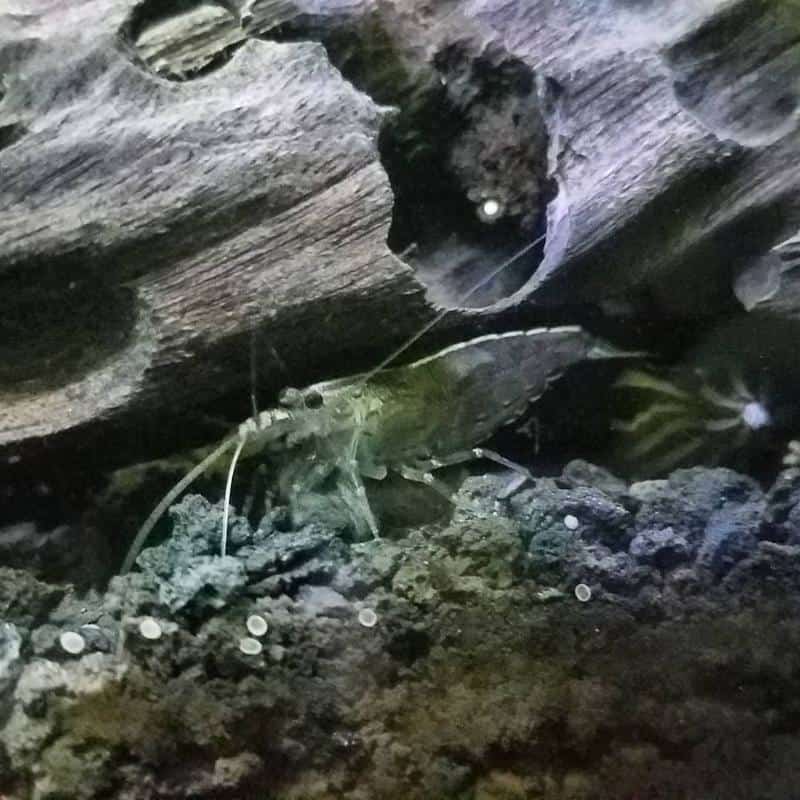
Speaking of reproduction, Nerite snail eggs are fertilized by male Nerites and eventually hatch in the presence of brackish water. Since this lack in fresh water, the eggs remain suspended and plastered on the glass as white seeds/spots.
This brings about an interesting question, how do you help Nerites reproduce when they live in freshwater tanks? Well, it is simple, through acclimation and transfer to brackish water.
Increase the salinity of the freshwater with Nerites before breeding season. Once the laying of eggs starts, proceed to acclimate the snails into a marine environment and let nature take its course. Once done, you can reintroduce them back to their last habitat.
Sensitivity to Bright Light
Nerite snails are very sensitive to bright light.
This includes bright aquarium tank lights, as well as the bright lights in the room and direct sunlight from outside. Bright light weakens the shells by causing them to dry, and this may lead to shell breaking or peeling off.
Mind the Nerites’ Habits
The Nerite snails are ingenious creatures that cling to anything in the aquarium. They often hold onto hard surfaces, from filter intakes to other dark parts on the glass, décor, and equipment. Use a scraper to remove them from entering hard-to-find places that can cause them to be crushed or unreachable.
It is also important to leave about one inch of clearance at the top of the water line—the Nerites climb along the glass wall, eating their way on anything they find. The clearance ensures they do not climb out of the tank. Also, keeping a lid on top will further deter them from leaving the habitat.
Related:
- Best Aquarium Fish that Eat Snails
- Bladder Snail Guide: Size, Lifespan, Care, Diet & More
- Assassin Snail Care Guide
- Is My Aquarium Snail Dead?
- Aquarium Snail Eggs: What to Do with Them?
Summing Up
Nerite snails are easy to maintain and provide an aesthetic appeal to a beginner’s aquarium tank. They are very calm and peaceful, perfect for a habitat filled with non-aggressive aquatics that do not feed on snails.
However, remember to have sufficient calcium when keeping these snails since it could be their undoing.